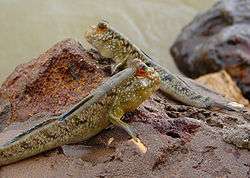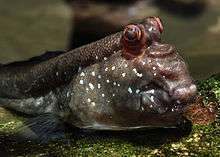Mudskipper
| Mudskippers | |
|---|---|
 | |
| Periophthalmus barbarus mudskippers in The Gambia | |
| Scientific classification | |
| Kingdom: | Animalia |
| Phylum: | Chordata |
| Superclass: | Osteichthyes |
| Class: | Actinopterygii |
| Superorder: | Acanthopterygii |
| Order: | Perciformes |
| Suborder: | Gobioidei |
| Family: | Gobiidae |
| Subfamily: | Oxudercinae |
| Genera | |
|
Apocryptes | |
| Synonyms | |
| |
Mudskippers are amphibious fish, presently included in the subfamily Oxudercinae,[1] within the family Gobiidae (gobies). Recent molecular studies do not support this classification, as oxudercine gobies appear to be paraphyletic relative to amblyopine gobies (Gobiidae: Amblyopinae), thus being included in a distinct "Periophthalmus lineage", together with amblyopines.[2] Mudskippers can be defined as oxudercine gobies that are "fully terrestrial for some portion of the daily cycle" (character 24 in Murdy, 1989[1]). This would define the species of the genera Boleophthalmus, Periophthalmodon, Periophthalmus, and Scartelaos as "mudskippers". However, field observations of Zappa confluentus suggest that also this monotypic genus should be included in this definition.[3] These genera presently include 32 species. Mudskippers use their pectoral fins and pelvic fins to walk on land [4][5] They typically live in intertidal habitats, and exhibit unique adaptations to this environment that are not found in most intertidal fishes, which typically survive the retreat of the tide by hiding under wet seaweed or in tide pools.[6]
Mudskippers are quite active when out of water, feeding and interacting with one another, for example, to defend their territories and court potential partners. They are found in tropical, subtropical, and temperate regions, including the Indo-Pacific and the Atlantic coast of Africa.
Adaptations

Compared with fully aquatic gobies, these fish present a range of peculiar behavioural and physiological adaptations to an amphibious lifestyle. Anatomical and behavioural adaptations that allow them to move effectively on land as well as in the water:.[5][7] As their name implies, these fish use their fins to move around in a series of skips.
| “ | Although mudskippers’ fins do not have a joint homologous to the elbow, the joint between the radials and the fin rays serves a functionally analogous role. | ” | |
| — Integrative and Comparative Biology, [8] | |||
| “ | The mudskipper pectoral fin differs from most actinopterygian fishes in that the radials of the mudskipper pectoral fin are elongate and protrude from the body wall. This unusual morphology creates a pectoral fin with two fin segments (the radials and the rays) and two movable hinge joints: a `shoulder' joint where the cleithrum meets the radials and a `intra-fin' joint where the radials meet the rays.[5] In addition, [...] the abductor superficialis muscle of the pectoral fin is divided into two sections (rather than being a single muscle, as is common with the rest of the Oxudercinae gobies) with one section inserting on the dorsal rays and the other section inserting on the ventral rays. | ” | |
| — The Journal of Experimental Biology, [9] | |||
Mudskippers have the ability to breathe through their skin and the lining of their mouth (the mucosa) and throat (the pharynx): This is only possible when the mudskippers are wet, limiting them to humid habitats and requiring they keep themselves moist. This mode of breathing, similar to that employed by amphibians, is known as cutaneous air breathing.[6] Another important adaptation that aids breathing while out of water is their enlarged gill chambers, where they retain a bubble of air. These chambers close tightly when the fish is above water, due to a ventromedial valve of the gill slit, keeping the gills moist, and allowing them to function while exposed to air. Gill filaments are stiff and do not coalesce when out of water.[6]
Digging deep burrows in soft sediments allow the fish to thermoregulate,[10] avoid marine predators during the high tide when the fish and burrow are submerged,[11] and lay their eggs.[12]
When the burrow is submerged, several mudskipper species maintain an air pocket inside it, which allows them to breathe in conditions of very low oxygen concentration.[13][14][15]
Species

The genus Periophthalmus is by far the most diverse and widespread genus of mudskipper. Eighteen species have been described.[17][18][19] Periophthalmus argentilineatus is one of the most widespread and well-known species. It can be found in mangrove ecosystems and mudflats of East Africa and Madagascar east through the Sundarbans of Bengal, Southeast Asia to Northern Australia, southeast China, and southern Japan, to Samoa and Tonga Islands.[1] It grows to a length of about 9.5 cm [1] and is a carnivorous opportunist feeder. It feeds on small prey such as small crabs and other arthropods.[20] However, a recent molecular study suggests that P. argentilineatus is in fact a complex of species, with at least three separate lineages, one in East Africa, and two in the Indo-Malayan region.[21] Another species, Periophthalmus barbarus, is the only oxudercine goby that inhabits the coastal areas of western Africa.[1]
References
- 1 2 3 4 5 Murdy EO (1989). "A Taxonomic Revision and Cladistic Analysis of the Oxudercine Gobies (Gobiidae: Oxudercinae)". Records of the Australian Museum. Suppl 11: 1–93. doi:10.3853/j.0812-7387.11.1989.93.
- ↑ Agorreta A.; San Mauro D.; Schliewen U. & Rüber L. (2013). "Molecular phylogenetics of Gobioidei and phylogenetic placement of European gobies". Molecular Phylogenetics and Evolution. 69(3): 619–633. doi:10.1016/j.ympev.2013.07.017.
- ↑ Polgar G.; Sacchetti A. & Galli P. (2010). "Differentiation and adaptive radiation of amphibious gobies (Gobiidae: Oxudercinae) in semi-terrestrial habitats". Journal of Fish Biology. 77: 1645–1664. doi:10.1111/j.1095-8649.2010.02807.x.
- ↑ Swanson BO, Gibb AC (2004). "Kinematics of aquatic and terrestrial escape responses in mudskippers" (PDF). The Journal of Experimental Biology. 207 (Pt 23): 4037–44. doi:10.1242/jeb.01237. PMID 15498949.
- 1 2 3 Harris VA (1960). "On the locomotion of the mudskipper Periophthalmus koelreuteri (Pallas): Gobiidae". Proceedings of the Zoological Society of London. 134: 107–35. doi:10.1111/j.1469-7998.1960.tb05921.x.
- 1 2 3 Graham JB, ed. (1997). Air–breathing Fishes. Evolution, Diversity and Adaptation. San Diego California: Academic Press.
- ↑ Pace CM & Gibb AC (2009). "Mudskipper pectoral fin kinematics in aquatic and terrestrial environments". Journal of Experimental Biology. 212 (14): 2279–2286. doi:10.1242/jeb.029041.
- ↑ S. M. Kawano and R. W. Blob (August 2, 2013). "Propulsive Forces of Mudskipper Fins and Salamander Limbs during Terrestrial Locomotion: Implications for the Invasion of Land" (PDF). Integrative and Comparative Biology. 53: 283–294. doi:10.1093/icb/ict051. PMID 23667046.
- ↑ Pace CM and Gibb AC (July 15, 2009). "Mudskipper pectoral fin kinematics in aquatic and terrestrial environments" (PDF). The Journal of Experimental Biology. 212: 2279–2286. doi:10.1242/jeb.029041. PMID 19561218.
- ↑ Tytler P, Vaughan T (1983). "Thermal Ecology of the Mudskippers Periophthalmus koelreuteri (Pallas) and Boleophthalmus boddaerti (Pallas), of Kuwait Bay". Journal of Fish Biology. 23 (3): 327–37. doi:10.1111/j.1095-8649.1983.tb02912.x.
- ↑ Sasekumar A, Chong VC, Lim KH, Singh HR (1994). "The Fish Community of Matang Mangrove Waters, Malaysia". In Sudara S, Wilkinson CR, Chou LM. Proceedings, Third ASEAN-Australia Symposium on Living Coastal Resources. Research papers. 2. Bangkok: Chulalonghorn University. pp. 457–64.
- ↑ Brillet C (1969). "Etude du comportement constructeur des poissons amphibies Periophthalmidae". Terre et la Vie (in French). 23 (4): 496–520.
- ↑ Ishimatsu A, Hishida Y, Takita T, Kanda T, Oikawa S, Takeda T, Khoo KH (1998). "Mudskipper Store Air in Their Burrows". Nature. 391 (6664): 237–8. doi:10.1038/34560.
- ↑ Ishimatsu A, Takeda T, Kanda T, Oikawa S, Khoo KH (2000). "Burrow environment of mudskippers in Malaysia". Journal of Bioscience. 11 (1–2): 17–28.
- ↑ Lee HJ, Martinez CA, Hertzberg KJ, Hamilton AL, Graham JB (2005). "Burrow air phase maintenance and respiration by the mudskipper Scartelaos histophorus (Gobiidae: Oxudercinae)". The Journal of Experimental Biology. 208 (Pt 1): 169–77. doi:10.1242/jeb.01361. PMID 15601887.
- ↑ Polgar G, Malavasi S, Cipolato G, Georgalas V, Clack JA, Torricelli P (2011). "Acoustic Communication at the Water's Edge: Evolutionary Insights from a Mudskipper". PLOS ONE. 6 (6): e21434. doi:10.1371/journal.pone.0021434.
- ↑ Larson HK, Takita T (2004). "Two new species of Periophthalmus (Teleostei: Gobiidae: Oxudercinae) from northern Australia, and a re-diagnosis of Periophthalmus novaeguineaensis". The Beagle, Records of the Museums and Art Galleries of the Northern Territory. 20: 175–85.
- ↑ Jaafar Z, Perrig M, Chou LM (2009). "Periophthalmus variabilis (Teleostei: Gobiidae: Oxudercinae), a valid species of mudskipper, and a re-diagnosis of Periophthalmus novemradiatus". Zoological Science. 26 (4): 309–14. doi:10.2108/zsj.26.309. PMID 19798926.
- ↑ Jaafar Z, Larson HL (2008). "A new species of mudskipper, Periophthalmus takita (Teleostei: Gobiidae: Oxudercinae), from Australia, with a key to the genus". Zoological Science. 25 (9): 946–52. doi:10.2108/zsj.25.946. PMID 19267605.
- ↑ Milward, NE (1974). Studies on the taxonomy, ecology and physiology of Queensland mudskippers (unpubl. Ph.D. dissertation ed.). Brisbane: University of Queensland.
- ↑ Polgar G, Zane L, Babbucci M, Barbisan F, Patarnello T, Rüber L, Papetti C (2014). "Phylogeography and demographic history of two widespread Indo-Pacific mudskippers (Gobiidae: Periophthalmus).". Molecular Phylogenetics and Evolution. 73: 161–76. doi:10.1016/j.ympev.2014.01.014.
External links
| Wikimedia Commons has media related to Oxudercinae. |
- FishBase entry on Gobiidae
- Gobioid Research Institute
- Mudskipper Page for aquarists
- The Mudskipper: a website on mudskippers or The Mudskipper
- Fish out of Water: Qatar Mudskippers
- Giant Mudskippers - Periophthalmodon schlosseri
- Mudskipper photos by Daniel Trim
